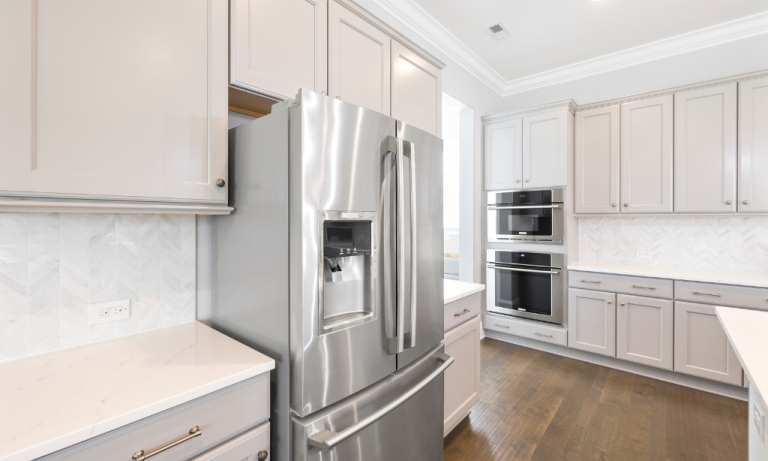Why the Fridge Is Not Cold But The Freezer Is: Troubleshooting and Solutions
A common reason for a fridge not being cold while the freezer is working fine is a malfunctioning evaporator fan. This fan is responsible for circulating cold air from the freezer to the fridge. When it fails, the freezer stays cold, but the fridge warms up. Another possibility could be blocked vents or air ducts preventing proper airflow. Regular maintenance, including cleaning coils and checking fans, can help prevent these issues. If troubleshooting doesn’t work, it’s advisable to seek professional help for further diagnosis and repair.
How a Refrigerator Works
Refrigerators operate on a closed-loop system known as the refrigeration cycle. This ingenious process harnesses the principles of thermodynamics to maintain a cool interior environment.
Refrigeration Cycle Overview
The cycle begins with a refrigerant, typically a special type of gas or liquid, that circulates through the system. It undergoes a continuous cycle of compression, condensation, expansion, and evaporation.
Compressor
The compressor is the heart of the system. It’s responsible for compressing the low-pressure, low-temperature refrigerant gas, causing its temperature and pressure to rise significantly. This high-pressure gas is then sent to the condenser.
Condenser
In the condenser, the hot, high-pressure gas releases its heat to the surrounding environment, causing it to condense into a high-pressure liquid. This liquid is then sent to the expansion valve.
Expansion Valve
The expansion valve is a small, metering device that rapidly reduces the pressure of the refrigerant. As it passes through the valve, the refrigerant undergoes a phase change, becoming a low-pressure, low-temperature mixture of liquid and gas. This mixture is then directed to the evaporator.
Evaporator
Inside the refrigerator, the low-pressure mixture enters the evaporator coils. Here, it absorbs heat from the interior, causing it to boil and evaporate back into a low-pressure gas. This process extracts heat from the contents of the refrigerator, effectively cooling them.
Thermostat
The thermostat serves as the control center, monitoring the temperature inside the fridge. When the temperature rises above the desired level, it signals the compressor to start the cycle anew. Once the desired temperature is reached, the compressor is turned off.
Differentiation between Fridge and Freezer Compartments
Differentiation between Fridge and Freezer Compartments:
Temperature Range
- Fridge: The fridge compartment maintains temperatures above freezing, typically between 34 to 40 degrees Fahrenheit (1 to 4 degrees Celsius). This range is ideal for storing fresh produce, dairy, and other perishables.
- Freezer: The freezer compartment operates at much lower temperatures, usually around 0 degrees Fahrenheit (-18 degrees Celsius) or lower. It’s designed for long-term storage of frozen foods.
Purpose
- Fridge: It’s intended for short-term storage and preservation of perishable items. This compartment is suitable for items that will be consumed within a few days to a couple of weeks.
- Freezer: The freezer is designed for long-term storage of items that need to be preserved for extended periods, often several months.
Storage Conditions
- Fridge: The environment in the fridge compartment is relatively humid to maintain the freshness of fruits, vegetables, and other perishables. It’s not suitable for items that need to be completely frozen.
- Freezer: The freezer maintains very low humidity levels to prevent freezer burn and ice crystal formation on stored items. It’s ideal for items that need to be frozen solid.
Shelving and Organization
- Fridge: Shelves in the fridge compartment are designed for easy access to frequently used items. They are typically adjustable to accommodate different-sized containers.
- Freezer: Freezer compartments often have fixed shelves and drawers that allow for efficient stacking and organization of frozen goods.
Types of Items Stored
- Fridge: It’s suitable for items like fresh fruits and vegetables, dairy products, beverages, condiments, and leftovers.
- Freezer: This compartment is ideal for storing frozen fruits and vegetables, meat, fish, ice cream, and other foods that need to be kept at extremely low temperatures.
Temperature Control and Regulation
- Fridge: The temperature control for the fridge compartment allows for slight adjustments within the recommended range.
- Freezer: The temperature control in the freezer is typically more sensitive and allows for precise adjustments to maintain sub-zero temperatures.
Read more GE Profile Refrigerator Not Cooling But Freezer Is Fine [Let’s Fix It!]
Common Reasons for a Warm Fridge
Thermostat Settings
Incorrect thermostat settings can lead to a warmer-than-desired fridge. Make sure the thermostat is set to the recommended temperature range, usually between 34 to 40 degrees Fahrenheit (1 to 4 degrees Celsius).
Blocked Air Vents
Blocked or obstructed air vents within the fridge can disrupt the airflow, preventing proper circulation of cold air. This can result in uneven cooling or warm spots.
Dirty Condenser Coils
Accumulated dust and debris on the condenser coils can reduce their ability to dissipate heat, leading to inadequate cooling. Regular cleaning of the coils is essential for optimal fridge performance.
Faulty or Overworked Compressor
A malfunctioning compressor may struggle to maintain the desired temperature. Additionally, if the compressor is constantly running, it can lead to overheating and reduced cooling efficiency.
Improper Door Seal
A compromised door seal allows warm air from the surroundings to enter the fridge, causing the interior temperature to rise. Inspect the gasket and replace it if it’s damaged or worn.
Inadequate Air Circulation
Overloading the fridge with too many items or improperly arranging them can impede the flow of cold air. Ensure there’s enough space for air to circulate freely.
Malfunctioning Evaporator Fan
The evaporator fan circulates cold air from the freezer to the fridge compartment. If it’s not functioning correctly, the fridge may become warmer than usual.
Refrigerant Leak
A refrigerant leak can disrupt the cooling process, causing the fridge to lose its ability to maintain low temperatures. A professional technician should address this issue.
Faulty Temperature Control Thermostat
If the thermostat that regulates the fridge’s temperature is malfunctioning, it may not signal the compressor to start when needed, resulting in inadequate cooling.
Power Supply Issues
Ensure that the fridge is receiving a stable and adequate power supply. Electrical problems can lead to improper functioning of the cooling system.
Old or Failing Components
Over time, various components like the compressor, condenser, or thermostat may wear out or become less efficient, leading to warmer temperatures inside the fridge.
Read more Kenmore Fridge Not Cooling But Freezer Working (Fixes 2024)
Troubleshooting Steps By Steps
Troubleshooting Steps for a Warm Fridge:
1. Check Thermostat Settings
– Ensure the thermostat is set to the recommended temperature range (usually between 34 to 40 degrees Fahrenheit or 1 to 4 degrees Celsius). Adjust if necessary.
2. Inspect Door Seal
– Examine the gasket around the door for any signs of wear, cracks, or gaps. Replace the seal if it’s damaged to prevent warm air from entering.
3. Clear Air Vents
– Ensure that air vents inside the fridge and freezer compartments are not blocked by food items or containers. Proper airflow is essential for efficient cooling.
4. Clean Condenser Coils
– Remove accumulated dust and debris from the condenser coils using a vacuum cleaner or a coil brush. Clean coils allow for better heat dissipation.
5. Maintain Adequate Space
– Avoid overloading the fridge with too many items, as it can obstruct airflow. Allow enough space for air circulation.
6. Check Evaporator Fan
– Open the freezer and listen for the sound of the evaporator fan running. If it’s not functioning, it may need to be replaced.
7. Inspect Compressor
– Listen for any unusual noises coming from the compressor. If it’s constantly running or making unusual sounds, it may require professional attention.
8. Look for Refrigerant Leaks
– Check for any signs of oil or residue around the fridge, which may indicate a refrigerant leak. If suspected, contact a technician for repairs.
9. Verify Power Supply
– Ensure the fridge is plugged in securely and that there are no issues with the electrical outlet. Check the circuit breaker to make sure it hasn’t tripped.
10. Test Temperature Control Thermostat
– Turn the thermostat knob from its lowest setting to its highest and listen for a click. If you don’t hear a click, the thermostat may be faulty and should be replaced.
11. Monitor for Improvements
– After making adjustments or performing maintenance, give the fridge some time to reach the desired temperature. Monitor its performance to see if there are any improvements.
12. Consult the Manual
– Refer to the user manual for specific troubleshooting steps and recommendations provided by the manufacturer.
Read more Your GE Refrigerator Not Cooling But Freezer Working? (Fixes 2024)
FAQ:
Q: What should I do if my fridge is not cooling properly but the freezer is working fine?
A: First, check the thermostat settings for both compartments. Ensure the fridge’s thermostat is set within the recommended temperature range. Clear any obstructions in the fridge’s air vents, and inspect the evaporator fan for any malfunctions.
Q: Could a malfunctioning compressor be the reason for this issue?
A: It’s possible. A faulty compressor can lead to inadequate cooling in both the fridge and freezer. If you suspect a compressor issue, it’s advisable to consult a professional technician for proper diagnosis and repair.
Q: How often should I clean the condenser coils to maintain optimal fridge performance?
A: It’s recommended to clean the condenser coils at least once or twice a year. This prevents dust and debris buildup, ensuring efficient heat dissipation and proper cooling.
Q: Can a refrigerant leak cause the fridge to be warm while the freezer remains cold?
A: Yes, a refrigerant leak can disrupt the cooling process, leading to insufficient cooling in both compartments. If you suspect a refrigerant leak, it’s crucial to contact a technician for repairs.
Q: What steps can I take to prevent this issue from occurring in the future?
A: Regular maintenance is key. Clean condenser coils, check and replace damaged door seals, and ensure proper airflow by not overloading the fridge. Additionally, monitor thermostat settings to avoid accidental adjustments.
Conclusion
Understanding the functionality of a fridge and freezer is paramount for efficient food storage. By grasping the refrigeration cycle and the roles of key components, users can optimize performance. Regular maintenance and prompt troubleshooting ensure these appliances operate reliably, safeguarding our perishables.
As an Amazon Associate I earn from qualifying purchases.
- Can You Put Clouds Shoes in the Washing Machine? With Tips & Tricks - April 10, 2024
- European Washing Machine vs American – History, Design, Technology - March 27, 2024
- Can You Put Boxing Gloves In The Washing Machine? – Expert Tips - March 25, 2024







![Samsung Refrigerator Not Cooling But Freezer Is Fine [Solved!]](https://homeplacetips.com/wp-content/uploads/2023/11/Why-is-the-Fridge-Not-Cooling-on-Your-Samsung-Fridge-Freezer_000044783-768x432.webp)